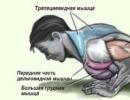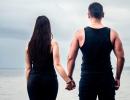Do you need back protection for snowboarding? Snowboard and ski protection is our guide. Do you need snowboard protection?
Skating with or without protection is an endless debate of all generations of snowboarders. Someone diligently proves that wearing a helmet is not cool, and someone does not go on the slope without it. We decided to collect some statistics and asked our riders how they feel about snowboard protection.
Zhenya Goldman
A professional snowboarder, one of those old female trinity who set the style and level of skiing.
I use protection almost always: shorts, my back is always on me! A snowboard helmet is also very necessary, but I will not hide it, I put it on every other time (usually on ski jumps). Here, probably, a tribute to fashion should be paid ... or who knows =) In fact, health is more expensive!
Having fallen hard on your head a couple of times, you understand how much a helmet is still needed. The problem is that you only understand after you've left. So, in this situation, I advise everyone to learn from the mistakes of others, and not from their own.
My compliment: Burton back and shorts, Bern helmet. I hope to get knee pads soon.
Were there situations when she really saved? Yes, the helmet definitely saved and more than once, if not for him, there would have been a couple more concussions! The back also helped out, mainly on the railings.
Some riders ignore snowboard protection, but that is a personal choice. If he is confident in his abilities and believes that he does not need protection, then this is his business =)
Grisha Fuzeev
Petersburg Gansta New School skier. One of the strongest riders in our country, a man who is ready to train endlessly.I use protection every time I ski. Of course, it is very important, because you never know when you will kiss.
I only wear a helmet, the Smith Maze brand.
There were situations when a helmet saved, and it also happened when there was no helmet, but it was needed =)
Do you look better without a helmet? Certainly! A dude without a helmet, especially on big trumps, gives the impression of either a super stable Pro or a loose head off. Of course he looks cooler.
Some ignore protection - this is a right, I don’t care about other people’s heads.
Valera Nozdrin
Newschool rider from Moscow. The lord of not only skis, but also women's hearts.
I always wear shorts. I use a helmet at competitions if required, in the mountains it’s mandatory and European parks, well, or if a meat day is planned, I also wear it, otherwise there are problems with the neck and sometimes there’s just no space =)
If you care about what might happen to you, then protection is very important, and not only in parks, streets, mountains where there are rocks, but also on tracks where nothing can depend on you, but depends on who is higher up the slope.
My stuff: Scott shorts and a Lazer Hoodie which is very light and doesn't put too much strain on the neck.
Were there situations when the defense saved? Yes, of course, you have to fall =) The helmet cracked when it hit the ice, but I felt great. The back protection came in handy when I was flying with my back on a slide box, but I left happy. Shorts also saved from falls on the fifth point, not so that you don’t feel anything right, but it’s more pleasant all the same.
Everyone chooses how and in what to ride, the main thing is to be aware of the risk when neglecting protection.
Anya Orlova
A snowboarder who devotes more to skiing than any other rider in our country. Only freeride.
I always ride with a helmet. I also have protective shorts, but they are more for warmth, and two types of knee pads, one simple for protection, the other fixing the knee - a brace. At many competitions I always ride in back protection, but usually a backpack is enough for me.
Protection is important both at the training stage and in the future. No one is safe from falls, from accidents too, sometimes even a small fall can bring big problems.
I have been riding in Giro helmets for several years, the rest of my protection has been for many years, it was enough for me to find a comfortable one once and now it lasts for many years. Of the innovations, I purchased a knee brace - Genumedi, in a specialized Medi orthopedic store. I didn’t have injuries, I just started to accumulate fatigue, I decided to protect myself from them in the future. Very cool thing, it is recommended for strong physical activity or for minor injuries such as sprains. Such a modern replacement elastic bandages, but much more thoughtful and convenient, of course the price is incomparable with bandages, but still it’s not bought for a year and they don’t save on health.
The defense has saved me many times. When I got into an avalanche, I was well carried over the rocks, but thanks to back protection and shorts, I escaped with a slight injury and rode the next day. Also, when I started learning to jump, back in Krasnoyarsk, I didn’t have a helmet, in one of the attempts I fell hard on my head and lost consciousness, then, waking up, I realized that I don’t remember anything for the last week, it lasted about an hour, and it was really scary, I'm sure that this would not have happened with a helmet.
I think that I look cool in a helmet, I don’t ride without it. I've also been lucky with Giro - they have a great selection of fun, colorful models for different riding styles. It is warmer in a helmet, the mask sweats less in a helmet, and a sense of security appears from it.
Yura Rudchik
The only person on our list who doesn't wear protection. A snowboarder from St. Petersburg, a participant in the Weare 2012 project and co-founder of the Terror brand.
I never use protection. Does she need? As much as it is important to each individual. It's all about habit, I don't have it. I can’t say that you look cooler without protection, everyone has their own style, so everything is not unambiguous.
They call it a snowboard olympic view sport, which consists in descending from mountains and slopes covered with snow on a snowboard. At first, these competitions were held only in winter, but some extreme sportsmen have learned to descend from sandy slopes in summer (sandboarding).
Very often, athletes ride on unprepared tracks at great speed. That is why they use various equipment to protect themselves from injury - helmets, equipment for arms, legs, joints, backs.
In 1998, in Nagano, during the Olympic competitions, snowboarding was included in the Olympic program for the first time.
Thoughts on protection
Protection for a snowboarder is very important - it is the first thing a wise rider acquires. Going out on the slope for the first time, many people forget about knee pads and helmets. They think that such an amazing event will not be spoiled by anything. After repeated falls, the broken parts of the body begin to hurt in athletes. As a rule, the first thought about equipment appears at this moment.
Those who have already been injured during training begin to think about protection in advance. They don't look back at skillful buddies who ride without a helmet or damage. And rightly so: protection for the snowboarder provides the athlete with the pleasure of riding. Equipped riders do not need to heal bruises.
Protection for the beginner snowboarder
Wondering if tailbone protection is important for snowboarders? When purchasing equipment, many people do not want to spend a lot of money. They don't know if they will like snowboarding, if they have enough money, spirit and time to continue. Therefore, we will now determine the minimum cost of equipment for beginners, taking into account the safety and maximum pleasure received from skiing.
Amateur training is carried out at ultra-low speeds with a huge number of falls from a height of average height. Riders primarily land on the following body parts:
- wrists (instinctively, all athletes fall on their arms extended forward);
- knees (during learning to ride on the front edge);
- buttocks (during learning to ski on the back edge).
Therefore, protection for the snowboarder must protect what is most injured.
knee pads
Knee pads are special knee pads. This equipment, as a rule, consists of a cup made of hard plastic. It is she who takes over the basic striking force. In accordance with the version, the product can be equipped with soft inserts made of foam material, which are placed below, above and on the sides of the knee.
The knee pad is attached in three ways:
- Straps below and above the knee - a budget option. Such a mount is not considered reliable, it can move during a side impact and fail to fulfill its purpose. Suitable for snowboarding enthusiasts riding at a minimum speed.
- Stocking. Here, the elbow is located in the middle of the fabric tube, which is equipped with various inserts. This modification is more reliable than the previous one, but has a very clumsy appearance.
- hybrid way. IN this case the stocking is fastened with straps to the top and bottom of the knee. This is the most expensive and reliable option.
It is necessary to note the magnificent modernization of the rigid knee pads, which are inclusions of elastic raw materials placed between the plastic cup and the knee. It can be foam rubber or other raw materials that soften the blow and take on its power. Some riders use pieces of fluffy polyethylene. After two or three workouts, they split lengthwise due to falls. But landing on them is very pleasant, as they are soft and comfortable.

Knee pads cost from 700 to 2500 rubles and more. Those who are going to try snowboarding for the first time can use equipment for volleyball or rollerblading.
Non-core products are popular due to their thickness. The most chubby volleyball knee pads cost about 300 rubles - this is not the highest fee for unbeaten knees.
Wrist guard, shorts
Protection for a snowboarder is necessary to get through the phase of relentless falls. After all, if training is not accompanied by injuries, the athlete learns faster and rides with pleasure.
- Protective shorts are called special equipment, equipped with inserts from a variety of materials (hard plastic and elastic synthetics). Such equipment protects the lateral surfaces of the thighs and tailbone from injuries, it is comfortable to sit on the lift in it, especially if it is wet. Shorts cost from 1600 to 3500 rubles, depending on the raw materials and the number of protective inserts, the thickness of the protection, the manufacturer and design. Of course, more expensive does not mean better. It is known that Russian enterprises create effective products at an affordable price. Choosing this product, you need to focus on convenience, thickness, quality of seams.
- Wrist protection consists of one or two plates placed in a case. They are made of plastic or steel and are attached to the hand in the form of a fingerless glove. This protection for snowboarders plays a very important role, as it fixes the hand and prevents it from excessive arching. In fact, this equipment prevents dislocations and fractures. The plates are invisible under the glove and are very comfortable. Their price is small - from 600 rubles, and it is known that efficiency does not depend on cost.
As a result, protection for novice snowboarders costs about 3,000 rubles. If you take some things from friends, it is much cheaper.
Protection for aces
By increasing speed, athletes increase the risk of injury. Of course, they rarely fall, but critically, there are collisions at speed with other snowboarders, and even with skiers. To stay healthy during training, riders stock up on extra gear.

In protection for snowboarding, professionals prefer a helmet. It is known that at low speed it is almost impossible to fall and injure your head. At an impressive speed, it can be smashed thoroughly. A helmet often saves you from trouble. It is made of hard plastic, which is able to absorb all the power of the push and prevent concussion. Most cases prove its real effectiveness.
Helmet neglect
Many snowboarders neglect their helmets and therefore their safety. They say that the product has too much mass, so it is uncomfortable. But when they go to the mountains, they get it anyway, because they don’t want to go to the hospital.
It is known that there are many cheap models of lightweight helmets. For example, the Head version has a mass of only 365 grams, while being very convenient and inexpensive.

Some athletes say they look ugly with a helmet on. Today you can find a product that will create an unforgettable style for the rider. You can choose a helmet to match the color of your eyes, hair, suit... When you are protected, you can move mountains!
Useful property of the helmet
The helmet has one more useful property: it warms the head in windy and frosty weather. Riders often ask the question: “Can I wear a hat under a helmet?” Many people know that because of it, a helmet can move when it falls.
Of course, you can wear a headgear under protection without losing safety, provided that it sits securely and comfortably on you. The hat also softens the impact when falling, because it is an additional layer. If the helmet worn on it moves, you need to purchase a different size or model.
In stores that sell snowboard protection (helmets, clothes), you can find special balaclavas that look like hats or light balaclavas. Sellers often say that helmets can be adjusted in size. This is not bad, but you should not rely on this nuance, because the product should be comfortable and fit snugly to the head.
Audio system
An audio system can be built into the helmet. Its most important purpose is the riders' dialogues during skiing. They are necessary in order to call for help if necessary and not get lost. Use headphones and a walkie-talkie for this.

Unfortunately, many athletes use this feature for other purposes and build a player into the helmet. Thus, they increase the pleasure received from skiing, but reduce safety: the snowboarder begins to be inattentive to the details of the route, the risk of collision and injury increases.
So how do you choose a helmet? When trying on, it is necessary to pay attention to the size and weight of the product (the helmet should fit snugly against the head, but not squeeze it and not disturb the athlete).
Mask
Snowboard protection is, in fact, sold in any sports shop. What is a mask? It protects the eyes and part of the face from snow, head wind and minor mechanical damage. Usually professionals who ride at high speeds need it.
Many people say that the mask is harmful because it reduces the viewing angle. It is wrong to think so. Firstly, this nuance depends on the model of the product. Secondly, the view is narrowed due to snow and air currents entering the eyes, and not due to poor equipment.
Under the helmet, the mask is selected so that there is no gap between the products. For example, the Head helmet is great only with a Scott mask.
Visor
It is known that the visor with which the mask is equipped has a large number of characteristics: contrast, color, light transmission, sharpness, viewing angle, and so on.
There are two types of visors:
- Spherical. In it, the reflection blurs to a circle with the effect of the “eye of a fish”. Spherical masks provide a wide viewing angle and are considered the best for vision: they do not distort the image, as they form a sphere around the eye. They are expensive.
- Cylindrical. Here the reflection resembles the outer surface of a cylinder, as it is stretched vertically. This product can be purchased at a low price.
Sellers may recommend mask models equipped with interchangeable visors. In general, it is very difficult to choose a visor for a certain mask model (usually outdated), it is cheaper to buy a new one. Therefore, it is better to buy a good product the first time, rather than changing visors.
Back protection
What is a snowboarder's back protector? It is used by professionals who ride at high speed. Indeed, on crowded slopes, when performing tricks, you can collide with colleagues and fly several meters.
Back equipment is made in different versions. The simplest, but quite effective, is the placement of several movable plates on the straps and a wide waist belt. It is inexpensive and effective protection. A more expensive example is equipped with plates attached to the back with a thin fabric vest. This equipment is also part of the “turtle”, which protects the chest and arms of the athlete from injury.

Previously, this product was made of hard plastic. Today, lighter raw materials are used, resembling foam. It is very soft, but at the moment of impact it becomes hard. Many riders do not dare to use this option, so they ride in plastic.
Before purchasing, be sure to try on the back protection, it should sit tight and not move under pressure. In general, any product may seem comfortable, but not fit the figure, so you need to look for a comfortable model.
Chest protection
It is impossible to tell everything about snowboard protection, but we will try to make out highlights. In order to go down the mountain on a simple soft snowboard, many wear a chest protector. At high speed, the slightest mistake, a stone on the track, or incorrect weight distribution can cause a rider to fall. To ride a couple of tens of meters by inertia on your own chest is not a pleasant test.
A small addition made in the form of a "turtle" or a protective vest helps the athlete feel safe and confident at any speed and not be afraid of injury.
Technologies and manufacturers
Snowboard protection is made using various technologies. For example, comfortable and soft knee pads become hard at the moment of impact. Technology comes from different areas, a lot has been borrowed from motorcyclists.
When purchasing a product, you can specify the manufacturer's brand: Rossignol, Uvex, Red, Burton. Well-known companies always have expensive products.

In general, it is interesting for everyone to see how any technology works to protect a snowboarder, everyone chooses their own option. Someone prefers brands, someone prefers price. Some do not like Dainese products: they say that this company makes heavy helmets and frivolous knee pads. But this enterprise is the market leader in protection, primarily motorcycle protection. In general, they usually pay attention to how the equipment is made and whether it sits comfortably. It must be remembered that the presence of equipment is much better than its absence.
Snowboarding is quite dangerous. High speed, sloping surface is difficult to avoid falls. Security must be given Special attention beginner snowboarders and experienced riders. Those who have recently decided to try their hand at this sport will have to fall a lot, which is why snowboarding protection is needed. Parts of the body such as the buttocks, knees and wrists are more affected. First of all, you should think about the safety of the head. Even with a slight blow to the head, there can be serious consequences.
Snowboarders wear a helmet and mask on their heads. This provides protection from shock and wind. At high speed on the snowy slopes, it is very easy to get frostbite on the skin of the face. When choosing a helmet, here you need to pay attention to several points:
- size;
- ventilation;
- adjustment;
- quality assurance;
- mask compatibility.
Important! Helmets are subjected to a kind of crash test, and the abbreviation of the testing company is applied to them if the product passes the test. Therefore, the presence of such an identification feature guarantees that it will withstand the strongest blow and save its head.
When choosing suitable protection, pay special attention to the fact that the helmet should sit tightly on the head, fix the neck, there should be no gaps, but it should not press. Together with a helmet, a mask is chosen, since they fit closely together. The mask should also not press on the nose. The glass of the glasses must be sun-protective and durable so that small pieces of ice and pebbles cannot break through it.
Wrist and hand safety
When losing balance, the snowboarder puts forward brushes. This is a completely normal reaction of the legs being attached to the board. Therefore, the wrists and hands in 40% of cases of falls suffer more than all other parts of the body. Protection is of two types:
- gloves with protective elements;
- separate elastic constructions with sewn-in hard plates.
To choose suitable for carpal joints, it is better to try on both. The second option may not fit gloves, but the first option does not feel as strong as a separate additional safety structure. Gloves also provide reliable protection of the palm from damage.
Protective shorts
The coccyx, buttocks and hips are beaten back "on one or two". Most often, beginners fall who are not used to the state when both feet are “glued” to the board. If you do not wear protective shorts, then after the first ride, all the muscles of the pelvis will beat off and the desire to ride will disappear. To prevent this from happening, you need to pick up reliable breeches with protective inserts.
Shorts are made of a special material that does not release heat, while helping to ensure that the surface of the body does not sweat. There are women's, men's and children's shorts. Polymer inserts for safety are different, more rigid and softer. Of course, with soft inserts it is more convenient to move, movements are not constrained, better maneuverability is felt. For beginners, it is better to give preference to those leggings that will provide more security, that is, with more rigid inserts.
Equipment for knees and elbows
For snowboarders, knee pads are made especially hard. There are many cases when the knee joints are injured and after that the riders can no longer do what they love. It is better to take care of a reliable one in advance to avoid serious damage.
Solid inserts go on top, bottom and sides of the knee joint. Knee pads have a difficult mission: to protect fragile joints and maintain mobility. If the knees can't bend, a straight-legged rider won't get far. knee pads release different types, depending on the attachment to the leg:
- with straps. Fastened above and below the knee. The most economical. Suitable for beginners. Experienced snowboarders ride at high speeds and the bindings may give way and come loose in a side impact.
- whole, put on a stocking. Uncomfortable when putting on, can slip during long and intense skiing.
- mixed. The most reliable option and the most expensive. The snowboarder puts on a knee pad with a stocking and fastens it with straps above and below the knee. They look bulky, but the security is top notch.
For maximum savings, riders use volleyball equipment. For this sport, knee pads are made that are hard enough to provide protection from hard impacts.
As for the elbows, similar equipment is selected here. The only difference is the size. The elbow pads are smaller, but the purpose is the same.
Back protection
Usually riders don't think about back protection as it is the most expensive piece of equipment. Experienced snowboarders who understand the dangers of high speeds keep their back and core safe. Some use special backpacks with hard inserts to ensure a soft landing on their back and avoid injury.
There are three options on the market:
- jacket;
- vest;
- "turtle".
The first option is equipped with inserts in the back, lower back, elbows, forearms, chest. The most important areas of the torso will be protected. With a vest, it is better to additionally purchase elbow pads. It provides security only to the spine, lower back and ribs. The "turtle" model is concentrated on the back, fastened with straps on the stomach. The emphasis is on the spine and lumbar.
The importance of equipment
Getting up on the board for the first time, the snowboarder will worry about his safety. This extreme view sports, without protection it is better not to risk it. Those who went out on the slope for the first time without equipment do not do it again. Repulsed buttocks, hands and knees for many years will remind you that safety is paramount. An experienced rider will give advice on the importance of protection. Of course, the first descent, one way or another, will be with an instructor, but no one is safe from falls.
- I'm just starting to ride. What protection do I need?
If you are a beginner skier, a helmet is enough. Buy the rest next year, if the need arises. By that time, your typical falls will be revealed and the style in which you want to progress will be determined.
If you are a beginner snowboarder, in addition to a helmet, knee pads, shorts and wrist protection are desirable. On the ass you will fall a lot and often. When you fall forward, your knees and wrists suffer, as you reflexively put your hands forward.
I'm learning tricks and I want to protect myself from injury, but friends say that protection will only hinder my movements. Is it true?
Not true. Properly selected protection is practically not felt on the body. But the selection of equipment for "jumping" types must be approached carefully. When choosing back protection - be sure to try it on with shorts! The tail of the "turtle" should not touch the protection of the coccyx during any movement, otherwise the shorts will slip. When you buy knee pads, jump in them and wave your legs - the fasteners should not interfere with blood circulation and freedom of movement.
- Is it hot in defense?
Good protective equipment It is made taking into account the features of thermoregulation of an actively moving person - it perfectly removes sweat and dries quickly. But be that as it may, this is another layer. So if you're wearing protection, especially full torso protection, your other clothing should be one less layer! Choose a lighter jacket or ride without a fleece, wearing protection right over your thermal underwear.
- Why protection for a freerider? He rides in puff!
Nothing like this. The freerider rides everywhere, overcoming any obstacles in his path: stones, forest, drops, fallen trees, pits and the like. Therefore, for off-piste skiing, a full set of protection is usually recommended, allowing you to not be afraid of the unexpected.
- Is it true that you can't learn how to fall correctly while skating in defense?
Not true. Nothing stops a rider from learning how to fall defensively. When a mother teaches a child to walk and put his hands forward when falling, she teaches him on a soft rug, and not on a rocky path, where he is likely to be injured. If the rider walks, constantly limping from sprains, bruised and abrasions, he will not learn to fall or ride faster.
When choosing elements of protection, remember: the presence of protection under clothing does not make you an inactive coward. Rather, on the contrary, it makes you bolder, more relaxed and allows you to freely enjoy the snow without worrying about the little things, and painlessly conquer more and more sports peaks! What we wish you!






